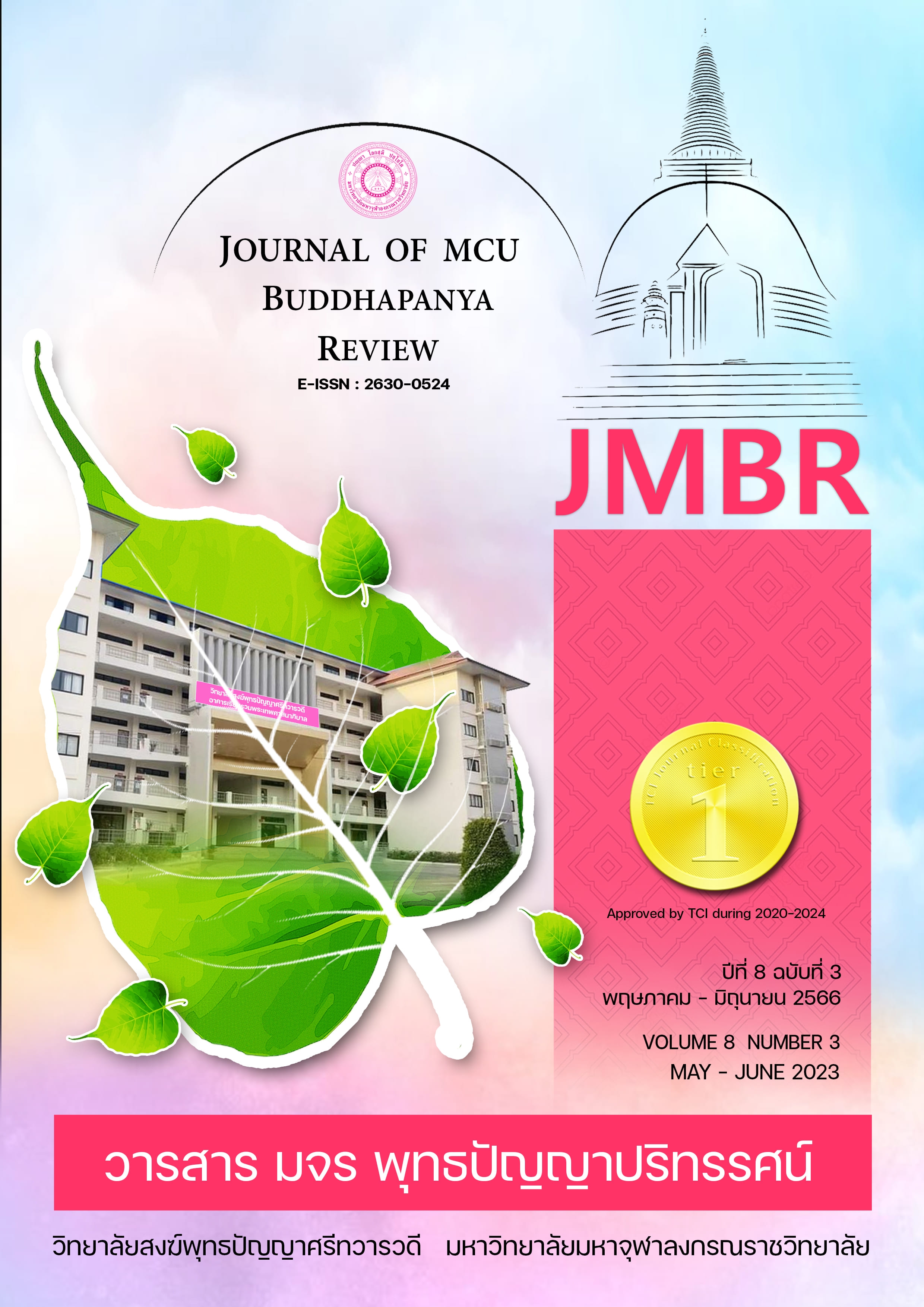ภาวะการนำและพระคติธรรมสมเด็จพระสังฆราชประทานเนื่องในโอกาสขึ้นปีใหม่
คำสำคัญ:
ภาวะการนำ, สมเด็จพระสังฆราช, คติธรรมบทคัดย่อ
บทความวิจัยนี้เป็นการศึกษาวิจัยเชิงคุณภาพเพื่อบุกเบิกองค์ความรู้เกี่ยวกับภาวะการนำในสมเด็จพระอริยวงศาคตญาณ สมเด็จพระสังฆราช สกลมหาสังฆปรินายก (อัมพร อมพโร) โดยใช้กรอบแนวคิดเชิงทฤษฎีเกี่ยวกับภาวะการนำการเปลี่ยนแปลง (Transformational Leadership) ของ Bernard Bass และ Bruce Avolio และใช้การวิจัยเชิงคุณภาพ เพื่อวิเคราะห์ประเภทภาวะการนำที่สมเด็จพระอริยวงศาคตญาณ
สมเด็จพระสังฆราช สกลมหาสังฆปรินายก (อัมพร อมพโร) ทรงแสดงผ่านพระคติธรรมที่ประทานเนื่องในโอกาสขึ้นปีใหม่ระหว่างปี พ.ศ. 2561 – 2566 วิธีการรวบรวมข้อมูล ผู้วิจัยใช้วิธีการเก็บข้อมูลเชิงทุติยภูมิ และตรวจสอบความถูกต้องของข้อมูลด้วยเทคนิคตรวจสอบแบบสามเส้า และวิเคราะห์โดยวิธีการวิเคราะห์เนื้อหา ผลการวิจัยพบว่า สมเด็จพระอริยวงศาคตญาณ (อัมพร อมฺพโร) ทรงแสดงภาวะการนำทั้ง 5 รูปแบบ ได้แก่ 1) วิสัยทัศน์ 2) การเป็นแบบอย่าง 3) สร้างเป้าหมาย 4) การกระทำ และ 5) การศึกษา อย่างไรก็ดี แม้ว่าทรงแสดงภาวะการนำทั้ง 5 รูปแบบ แต่ทรงแสดงภาวะการนำด้านการศึกษาหรือการเรียนรู้เพื่อเสริมสมบูรณ์แห่งตนของผู้ตามเป็นสำคัญ
เอกสารอ้างอิง
Bass, B. M., & Avolio, B. J. (1994). Improving organizational effectiveness through transformational leadership. Thousand Oaks: Sage.
Bass, B. M., & Steidlmeier, P. (1999). Ethics, character, and authentic transformational leadership behavior. The leadership quarterly, 10(2), 181-217.
Beckhard, R., M. Goldsmith, and F. Hesselbein. (1997). The Leader of the Future: New Visions, Strategies and Practices for the Next Era. New York: Jossey Bass.
Bryman, A. (1992). Charisma and leadership in organizations. London, UK: SAGE.
Cardona, P. (2000). Transcendental leadership. Leadership & Organization Development Journal, 21(4), 201-207.
Day, D. V., & Antonakis, J. (Eds.). (2012). The nature of leadership (2nd ed.). Thousand Oaks, CA: SAGE.
Dess, G. G., & Picken, J. C. (2000). Changing roles: Leadership in the 21st century. Organizational dynamics, 28(3), 18-34.
Dinh, J. E., Lord, R. G., Gardner, W. L., Meuser, J. D., Liden, R. C., & Hu, J. (2014). Leadership theory and research in the new millennium: Current theoretical trends and changing perspectives. The leadership quarterly, 25(1), 36-62.
Dyson, K. (1998). Chancellor kohl as strategic leader: The case of economic and Monetary Union. German Politics, 7(1), 37-63.
Gardner, W. L., Lowe, K. B., Meuser, J. D., Noghani, F., Gullifor, D. P., & Cogliser, C. C. (2020). The leadership trilogy: A review of the third decade of the leadership quarterly. The Leadership Quarterly, 31(1), 101379.
Gardner, W. L., Lowe, K. B., Moss, T. W., Mahoney, K. T., & Cogliser, C. C. (2010). Scholarly leadership of the study of leadership: A review of The Leadership Quarterly's second decade, 2000–2009. The leadership quarterly, 21(6), 922-958.
Hendrickson, R. (2004). Leadership at NATO: Secretary General Manfred Woerner and the Crisis in Bosnia. Journal of Strategic Studies, 27(3), 508-527.
House, R. J., & Howell, J. M. (1992). Personality and charismatic leadership. The leadership quarterly, 3(2), 81-108.
Jayaphorn, C. (2018). Sermons of His Holiness Somdet Phra Ariyavongsagatayana: Part II. Unpublished manuscript.
Jayaphorn, C. (2019). Sermons of His Holiness Somdet Phra Ariyavongsagatayana: Part III. Unpublished manuscript.
Jayaphorn, C. (2020). Sermons of His Holiness Somdet Phra Ariyavongsagatayana: Part IV. Unpublished manuscript.
Jayaphorn, C. (2021). Sermons of His Holiness Somdet Phra Ariyavongsagatayana: Part V. Unpublished manuscript.
Jayaphorn, C. (2022). Sermons of His Holiness Somdet Phra Ariyavongsagatayana: Part VI. Unpublished manuscript.
Kaarbo, J. (1997). Prime Minister Leadership Styles in Foreign Policy Decision‐Making: A Framework for Research. Political psychology, 18(3), 553-581.
Kotter, J. P. (1990). A Force for Change: How Leadership Differs from Management. New York: Free Press.
Matthews, R., & Ross, E. (2010). Research methods: A practical guide for the social sciences. Harlow, UK: Pearson Education Ltd.
Mumford, M. D. (2006). Pathways to outstanding leadership: A comparative analysis of charismatic, ideological, and pragmatic leaders. Mahwah, NJ: Erlbaum.
Namuangrak, C., & Ploychum, S. (2015). Leadership: Somdet Phamahasamana Chao Kromphaya Vajirananavarorasa. Academic Journal Phranakhon Rajabhat University, 4(1), 141–147.
Narbona, J. (2016). Digital leadership, twitter and Pope Francis. Church, Communication and Culture, 1(1), 90-109.
Northouse, P. G. (2015). Leadership: Theory and Practice. Thousand Oaks: SAGE.
Peterson, R. S., Smith, D. B., Martorana, P. V., & Owens, P. D. (2003). The impact of chief executive officer personality on top management team dynamics: one mechanism by which leadership affects organizational performance. Journal of applied Psychology, 88(5), 795.
Rebore, R., & Walmsley, A. (2009). Genuine school leadership: Experience, reflection and beliefs. Thousand Oaks, California: Corwin Press.
Robbins, S. P., & Judge, T. (1997). Organizational Behavior. New Jersey: Pearson Education.
Rost, J. C. (1991). Leadership for the twenty-first century. New York, NY: Praeger.
Saunders, E. N. (2014). Leaders at War: How Presidents Shape Military Interventions. Ithaca, NY: Cornell University Press.
Seltzer, J., & Bass, B. M. (1990). Transformational leadership: Beyond initiation and consideration. Journal of management, 16(4), 693-703.
Sutheejariyawat, P. (2019). The Roles of Buddhist Monks in the 21st Century. Buddhism in Mekong Region Journal, 2(2), 1-9.
Tan, M., Fatt Hee, T., & Yan Piaw, C. (2015). A qualitative analysis of the leadership style of a vice-chancellor in a private university in Malaysia. Sage Open, 5(1), 1-11.
ดาวน์โหลด
เผยแพร่แล้ว
รูปแบบการอ้างอิง
ฉบับ
ประเภทบทความ
สัญญาอนุญาต
ลิขสิทธิ์ (c) 2023 วารสาร มจร พุทธปัญญาปริทรรศน์

อนุญาตภายใต้เงื่อนไข Creative Commons Attribution-NonCommercial-NoDerivatives 4.0 International License.



